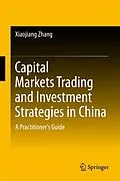This book covers in detail the building blocks of Chinese capital markets at the financial instrument level, the analytical pricing term structure of those instruments, the macro and industry economic framework and progress of the liberalization processes at work in the respective markets, the interaction of various participants in the markets, their trading and investment objectives and rationales, some of the most frequently applied trading and investment strategies, and risk management techniques. The book will especially benefit financial practitioners with in-depth knowledge of their respective capital markets area regarding foreign exchange, money markets, fixed income, and related derivatives, and who have a keen interest in gaining deeper insights into the Chinese market so as to develop or strengthen their global strategy application and risk management practice.
Autorentext
Xiaojiang Zhang worked at various large global financial institutions in the areas of foreign exchange, fixed income, derivatives trading and portfolio management. Author of Capital Markets Trading and Investment Strategies in China published by Springer in 2018. Author of Mechanical Analysis of China's Macro Economic Structure published by Springer in 2020. Two times top economic think tank award winners.
Inhalt
Part 1. Portfolio building blocks covering foreign exchange, money markets, fixed Income and derivatives Instruments
1Traded Foreign Exchange Instruments
a) Onshore CNY FX instruments
i. The markets, currency pairs traded and various market convention.
ii. FX Spot
iii. FX Forward
iv. FX Swap
v. FX Option
vi. The pricing mechanism in the onshore wholesale market and retail market.
b) Offshore CNY/CNH FX Instruments
i. The markets, currency pairs traded and various market convention.
ii. Deliverable vs. NDF
iii. FX forward trade
iv. FX Option
v. The pricing mechanism in the offshore wholesale and retail market
c) The capital flow and pricing transmission between Domestic CNY market and offshore CNY/CNH market
2Traded Money Market Instruments
a) Onshore CNY Market
i. Diversified participants
ii. Liquidity and historical developmentiii. Short maturity domination
iv. Instruments traded
1. Repo and Reverse Repo
2. Loan Deposit
3. Sec Lending
4. Cross-border CNY financing with Loan/Dep
5. CD
6. MM fund
v. Different MM indices: SHIBOR, Repo
b) Offshore FX management
i. Instruments traded
1. Repo and Reverse Repo
2. Loan Deposit
3. Commercial Paper
4. Short treasury securities
5. CD
6. FX Swap
ii. Transaction initiation channels
1. Loan/Deposit with Reuters and other terminals, Broker quotes, Counterparty quotes
2. FX with Reuters and other terminals, Counterparty quotes
3Fixed Income Instruments market condition, pricing mechanism, quoting and settlement convention
a) Instruments by issuers
i. Government Bond
ii. Local Government Debt
iii.
iv. Commercial Paper
v. Short Commercial Paper
vi. Central Bank Bill
vii. Corporate/ MTN
viii. ABS.
b) Instruments by cashflow structures
i. Fixed rate bond
ii. Floaters
iii. Option-embedded bonds
iv. Convertibles
v. Small-and-Medium Enterprise Collective Notes (SMECN)
vi. High yield
vii. Asset-Backed Securities
c) Market condition and trading convention
i. Exchange, interbank, and retail market
ii. Regulatory regime for the fixed income market place
iii. Participants distribution for trading
iv. Investment community distribution
d) Specific Interbank market vs. Exchange market differences
i. Liquidity and issuance
ii. Player participation and risk appetite
iii. Leverage usage
4Derivatives market condition, pric
ing mechanism, and trading conventiona) Swaps
i. Instrument definition, indices and application
ii. Participants and trading liquidity
b) Bond Futures
i. Contract definition and Instrument application
ii. Cheapest-to-deliver and IRR
iii. On-the-run bonds
Part 2. Macro Economics, Monetary Cycle, Industry Cycle, Monetary Condition, Supply and Demand
5Macro cycle
a) Import/Export cycle, Trade Balance, PMI Index
i. GDP and growth contribution
ii. Export dependency, market distribution, surplus and TPP
iii. PMI relevance, pork price and others
b) Real Estate Cycle
i. New construction, sales and existing inventory
ii. GDP and growth contribution
c) Government-driven Investment
i. Government spending and its hi...
